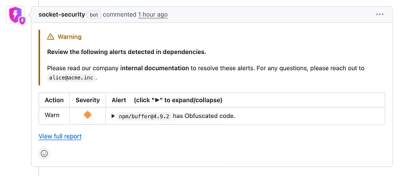
Security News
Crates.io Users Targeted by Phishing Emails
The Rust Security Response WG is warning of phishing emails from rustfoundation.dev targeting crates.io users.
Information at: http://www.communityengine.org
Requirements:
- RAILS VERSION 4.1.x
- RUBY 2.0.x
For Rails 3.x use the rails3.x branch
For Rails 4.0 use the rails4.0 branch
Gemfile:gem 'community_engine', '~> 3.2.0'
application_config.rb to your config directory. In it put (at least):configatron.community_name = "Your Application Name"
# See CE's application_config.rb to see all the other configuration options available
$ bundle install --binstubs
$ bin/rake community_engine:install:migrations
$ bin/rake db:migrate
config/routes.rb file:mount CommunityEngine::Engine => "/"
Delete the default views/layouts/application.html.erb that Rails created for you. Delete public/index.html if you haven't already.
Start your server!
$ bin/rails server
To override the default configuration, create an application_config.rb file in Rails.root/config.
The application configuration defined in this file overrides the one defined in the CommunityEngine gem.
This is where you can change commonly used configuration variables, like configatron.community_name, etc.
You can allow users to sign up and log in using their accounts from other social networks (like Facbeook, Twitter, LinkedIn, etc.). To do so, just add an initializer in your app's config/initializers directory called omniauth.rb and add the following lines:
Rails.application.config.middleware.use OmniAuth::Builder do
provider :twitter, configatron.auth_providers.twitter.key, configatron.auth_providers.twitter.secret
provider :facebook, configatron.auth_providers.facebook.key, configatron.auth_providers.facebook.secret, {:provider_ignores_state => true}
end
You must also add the corresponding provider gem, for example to use facebook login you will need to add the following to your gemfile:
gem 'omniauth-facebook'
See the OmniAuth Github repository for more information and configuration options.
By default CommunityEngine uses the filesystem to store photos.
To use Amazon S3 as the backend for your file uploads, you'll need to add a file called s3.yml to the application's root config directory (examples are in /community_engine/sample_files).
You'll need to change your configuration in your application_config.rb to tell CommunityEngine to use s3 as the photo backend. For more, see the Paperclip documentation on S3 storage for uploads: https://github.com/thoughtbot/paperclip/blob/master/lib/paperclip/storage/s3.rb.
Finally, you'll need an S3 account for S3 photo uploading.
CommunityEngine Users have a Role (by default, it's admin, moderator, or member).
Once logged in as an admin, you'll be able to toggle other users between moderator and member (just go to their profile page and look on the sidebar).
Admins and moderators can edit and delete other users posts.
There is a rake task to make an existing user into an admin:
$ rake community_engine:make_admin email=user@foo.com
(Pass in the e-mail of the user you'd like to make an admin)
Localization is done via Rails native I18n API. We've added some extensions to String and Symbol to let them respond to the .l method. That allows for a look up of the symbol (or a symbolized version of the string).
For complex strings with substitutions, Symbols respond to the .l method with a hash passed as an argument, for example:
:welcome.l :name => current_user.name
And in your language file you'd have:
welcome: "Welcome %{name}"
To customize the language, or add a new language create a new yaml file in Rails.root/config/locales. The name of the file should be LANG-LOCALE.yml (e.g. en-US.yml or es-PR). The language only file (es.yml) will support all locales.
Spam sucks. Most likely, you'll need to implement some custom solution to control spam on your site, but CE offers a few tools to help with the basics.
ReCaptcha: to allow non-logged-in commenting and use ReCaptcha to ensure robots aren't submitting comments to your site, just add the following lines to your application_config.rb:
:allow_anonymous_commenting => true,
:recaptcha_pub_key => YOUR_PUBLIC_KEY,
:recaptcha_priv_key => YOUR_PRIVATE_KEY
You can also require ReCaptcha on signup (to prevent automated signups) by adding this in your application_config.rb (you'll still need to add your ReCaptcha keys):
:require_captcha_on_signup => true
Akismet: Unfortunately, bots aren't the only ones submitting spam; humans do it too. Akismet is a great collaborative spam filter from the makers of Wordpress, and you can use it to check for spam comments by adding one line to your application_config.rb:
:akismet_key => YOUR_KEY
Ads are snippets of HTML that will be inserted into your templates. You have to declare where they show up in your view. For example, if you wanted a sidebar ad slot, add Ad.display() in your application template (or wherever your sidebar is):
#sidebar
%h1 This is the sidebar
=Ad.display(:sidebar, logged_in?)
Then on the admin dashboard, create an ad and use "sidebar" as the location to target it to the :sidebar slot. You can create multiple ads for the same slot and they'll rotate according to their weight.
To make a controller from your application use CE's layout and inherit CE's helper methods, make it inherit from BaseController. For example:
class RecipesController < BaseController
before_action :login_required
end
To override or modify a controller, helper, or model from CE, you can use the require_from_ce helper method. For example, to override a method in CE's User model, create app/models/user.rb:
class User < ActiveRecord::Base
require_from_ce('models/user')
#add a new association
has_many :recipes
#override an existing method
def display_name
login.capitalize
end
end
Any views you create in your app directory will override those in CommunityEngine. For example, you could create Rails.root/app/views/layouts/application.html.haml and have that include your own stylesheets, etc.
acts_as_taggable_on_steroidsBug tracking is via GitHub Issues
FAQs
Unknown package
We found that community_engine demonstrated a not healthy version release cadence and project activity because the last version was released a year ago. It has 1 open source maintainer collaborating on the project.
Did you know?

Socket for GitHub automatically highlights issues in each pull request and monitors the health of all your open source dependencies. Discover the contents of your packages and block harmful activity before you install or update your dependencies.

Security News
The Rust Security Response WG is warning of phishing emails from rustfoundation.dev targeting crates.io users.

Product
Socket now lets you customize pull request alert headers, helping security teams share clear guidance right in PRs to speed reviews and reduce back-and-forth.

Product
Socket's Rust support is moving to Beta: all users can scan Cargo projects and generate SBOMs, including Cargo.toml-only crates, with Rust-aware supply chain checks.